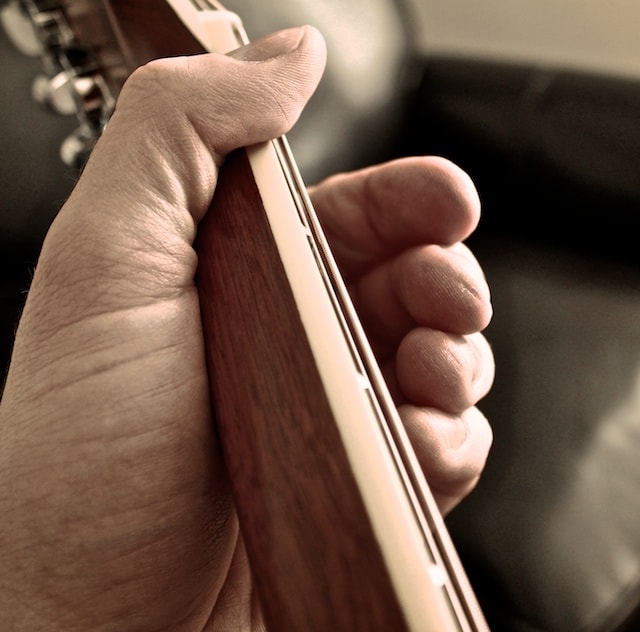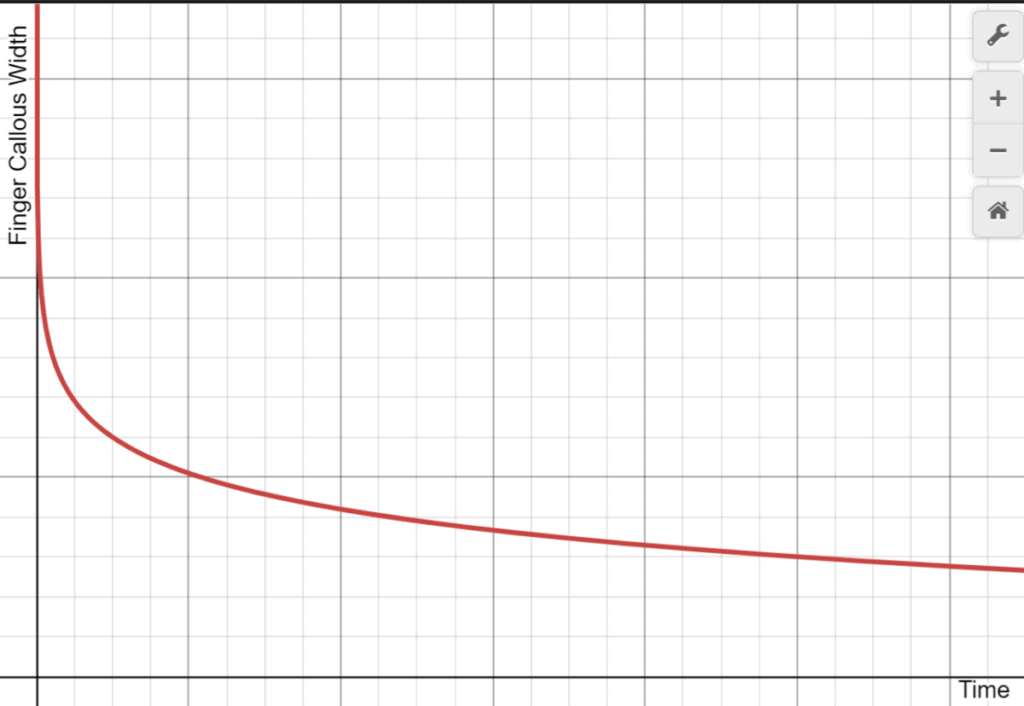This post contains affiliate links. We earn commissions if you purchase products from retailers after clicking on a link from our site. As an Amazon Associate, we earn from qualifying purchases.
Finger calluses are wonderful. They protect our hands and fingers from feeling pain from repetitive use. Maybe you’re asking because you play guitar, or lift weights, or perhaps you have a garden but is it possible for finger calluses to go away?

By the way, looking for recording equipment and musical instruments? Check out Sweetwater.com for microphones, monitors, audio interface or any other recording gear that you could ever need. (Affiliate Link)
By the way, looking for a guitar? Check out GuitarCenter.com for acoustic, electric, or classical guitars as well as all the guitar gear you could ever need. (Affiliate Link)
Finger calluses start to fade in only a couple weeks if you no longer participate in the activity that required them. For example, if you stop playing guitar for two months your calluses will fade dramatically and will be barely detectable.
Perhaps you don’t want your calluses, or perhaps you want to keep them in top shape–it doesn’t matter–your finger calluses will fade in only a short while.
How Long Does It Take For Finger Calluses to Fade?
Guitar players in particular rely on finger calluses–it’s really not possible to play for a long stretches of time without having numbness in your fingertips–otherwise it’d be too painful.
Every aspiring guitarists learns that it can take two or three weeks for solid calluses to form on the fingertips.
If you don’t play guitar for 7 weeks, the calluses (at least on my fingertips) fade 60-70%. I’m not sure if it’s nerve damage, but even if I don’t play for a while the pain is never as bad as it was when I first started playing guitar.
Some claim that their callouses can start fading even after a only a few days of disuse.
I find that the huge thick callouses fade quickly, but that you still keep a thicker layer of skin there for a lot longer.

I experienced this same phenomenon when I was weightlifting regularly. My palms got these awesome callouses that faded quickly when I got out of the habit, but the skin was still slightly thicker there for a lot longer, making it easier to lift on the occasion when I got to the gym, even if I wasn’t going regularly.
I say fade, but in reality a callous is just a thicker layer of skin. We are constantly shedding our skin (your vacuum cleaner knows that best), and if you don’t play guitar or lift weights or whatever it is that got you your callouses in the first place, your skin naturally peels and sheds over time, especially in those places where the extra skin is no longer needed.
Every Body is Different: The Public Answers
The reason why I mention this is that some people are pro-callous makers–and I’ve always wondered why.
I didn’t find the answer, but what I did do is ask a bunch of guitarists how long it took for their callouses to fade when they weren’t playing.
You might be surprised what they said:
Some said that their callouses started to fade after even a day and half of playing, some said a week.
This is what was super interesting to me: some said that over years and years of playing that the composition of their skin changed.
Instead of a thick callous that looks and feels different, it’s as if more layers of skin seemed to harden and thicken so the skin feels more natural, if more leathery and tough, to the point where the guitar strings don’t leave grooves in the skin after playing.
How To Maintain Your Callouses
The only way to keep your callouses is to maintain the activity where you got them! If you haven’t gotten callouses yet, it’s probably only been a few days–don’t worry, your body will automatically take care of this process.
Callouses are created from friction. If you don’t have any friction, or if you do things to reduce the friction, then then you will reduce your callouses.
Work your hands in your callous-building activity, be it guitar, lifting weights, or whatever. Try to avoid working to the point of blisters, as this will be too painful to practice and will set back your callous formation.
Also, make sure to avoid working to the point where you start to feel a dull ache in your hands (could be an onset of nerve damage). At this point it’s okay to take a break and come back to it so you don’t do permanent damage.
Avoid moisturizers and lotions as these reduce the friction of your hands. If you suffer from cracked knuckles–try applying lotion only on your knuckles and leave the areas you want to form callouses alone.
How To Get Rid Of Your Callouses
The key to getting rid (or at least reducing) your callouses is to reduce friction.
If you’re lifting weights, then start wearing gloves. Don’t worry, lots of tough people do this so it’s not a cop out. Moisturize your hands to reduce friction.
You can always file your callouses down. Using any abrasive object you can scrape away any dead skin just like you would at any other time.
People use something like this for their feet (Amazon), or perhaps they use a pumice stone (Amazon).
A warning about filing your callouses: remember that your callouses got there from excessive friction, and filing away your callouses is using friction to get rid of them. So, to not make your callouses come back bigger than before, make sure you don’t try to sand your entire callous all down at once.
Also, if filing down callouses, make sure and soften the skin with warm soapy water, as advised by Mayoclinic.
How Long Does It Take For Calluses To Form On Fingers?
So we’ve talked at length about how long it takes for callouses to go away, but how long does it take to form them on your fingertips? It’s mostly guitarists that care about this or anyone who plays a percussive stringed instrument (like the bass).
This of course varies from player to player and from how long your practice. But generally, you will start to feel callouses to form even within a few days of practice. After two weeks, you will likely only feel a small part of the discomfort that you started with.
After a month of consistent practice, you probably won’t even notice any fingertip discomfort during practice (unless you have bruised skin).
So, in general it follows a pattern like this: (this assumes daily guitar practice)
| 0-3 days | Painful, can only play 5-10 minutes at a time |
| 3-7 days | Callouses forming but still painful, only can play 10-15 minutes reasonably comfortably |
| 7-14 days | Callouses are either fully formed or are close |
| 14-28 days | Your callouses are fully formed externally and you can play for at least 30 minutes comfortably |
And then at some point after several months and even years of practicing, as some guitarists report, your fingers may feel different than they had a month into playing, where the skin doesn’t feel as unnatural and bulky, but rather your skin feels tough.
I am not at that point, probably, but I have noticed that even after long spells of not playing the guitar my fingertips on my left hand feel different than the fingertips of my right hand. Kind of cool!
